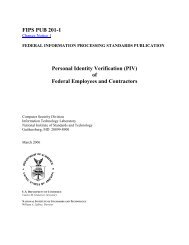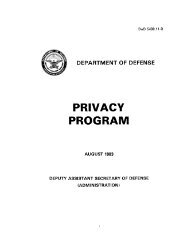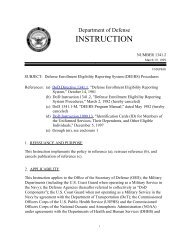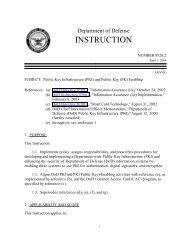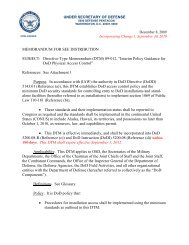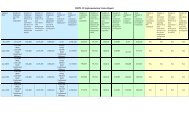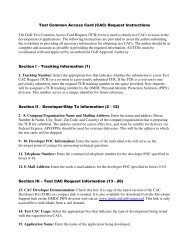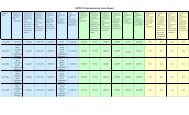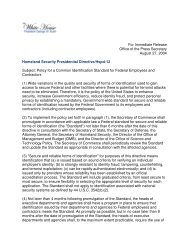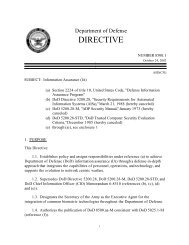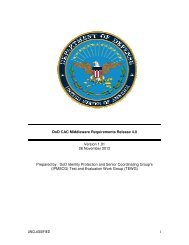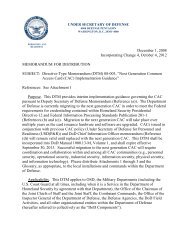DoD Instruction 8500.2 - Common Access Card (CAC)
DoD Instruction 8500.2 - Common Access Card (CAC)
DoD Instruction 8500.2 - Common Access Card (CAC)
You also want an ePaper? Increase the reach of your titles
YUMPU automatically turns print PDFs into web optimized ePapers that Google loves.
DODI <strong>8500.2</strong>, February 6, 2003<br />
Subject<br />
Area<br />
Control Number, Name and Text<br />
Security Design and Configuration<br />
DCMC-1<br />
Mobile Code<br />
The acquisition, development, and/or use of mobile code to be deployed in <strong>DoD</strong> systems<br />
meets the following requirements:<br />
(1) Emerging mobile code technologies that have not undergone a risk assessment by<br />
NSA and been assigned to a Risk Category by the <strong>DoD</strong> CIO is not used.<br />
(2) Category 1 mobile code is signed with a <strong>DoD</strong>-approved PKI code signing<br />
certificate; use of unsigned Category 1 mobile code is prohibited; use of Category 1 mobile<br />
code technologies that cannot block or disable unsigned mobile code (e.g., Windows<br />
Scripting Host) is prohibited.<br />
(3) Category 2 mobile code which executes in a constrained environment without<br />
access to system resources (e.g., Windows registry, file system, system parameters,<br />
network connections to other than the originating host) may be used.<br />
(4) Category 2 mobile code that does not execute in a constrained environment may be<br />
used when obtained from a trusted source over an assured channel (e.g., SIPRNET, SSL<br />
connection, S/MIME, code is signed with a <strong>DoD</strong>-approved code signing certificate).<br />
(5) Category 3 mobile code may be used.<br />
(6) All <strong>DoD</strong> workstation and host software are configured, to the extent possible, to<br />
prevent the download and execution of mobile code that is prohibited.<br />
(7) The automatic execution of all mobile code in email is prohibited; email software is<br />
configured to prompt the user prior to executing mobile code in attachments.<br />
Security Design and Configuration<br />
DCNR-1<br />
Non-repudiation<br />
NIST FIPS 140-2 validated cryptography (e.g., <strong>DoD</strong> PKI class 3 or 4 token) is used to<br />
implement encryption (e.g., AES, 3DES, DES, Skipjack), key exchange (e.g., FIPS 171),<br />
digital signature (e.g., DSA, RSA, ECDSA), and hash (e.g., SHA-1, SHA-256, SHA-384,<br />
SHA-512). Newer standards should be applied as they become available.<br />
Security Design and Configuration<br />
DCPA-1<br />
Partitioning the Application<br />
User interface services (e.g., web services) are physically or logically separated from data<br />
storage and management services (e.g., database management systems). Separation<br />
may be accomplished through the use of different computers, different CPUs, different<br />
instances of the operating system, different network addresses, combinations of these<br />
methods, or other methods as appropriate.<br />
Security Design and Configuration<br />
DCPB-1<br />
IA Program and Budget<br />
A discrete line item for Information Assurance is established in programming and budget<br />
documentation.<br />
IA Service<br />
Integrity<br />
Integrity<br />
Integrity<br />
Availability<br />
67 ENCLOSURE 4, ATTACHMENT 2



